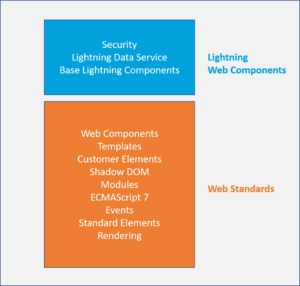Lightning Web Components was a hot topic at Salesforce’s annual Dreamforce conference and continues to be top of mind with clients. Companies at varying stages in their Salesforce journey — from rookies to experienced users — are looking to optimize and modernize their existing Salesforce solutions with its latest technologies, in order to keep meeting and exceeding their business and technology objectives. So, we were excited to take a deeper dive into the relatively new Salesforce Lightning Web Components (LWC) at Dreamforce.
Birth of Lightning Web Components
For decades, many of the leading standards organizations were in competition to provide their own web standards, which ultimately stalled any significant innovation in web development. Finally, in 2014, those key standards bodies came together to agree upon a collective set of web standards. As a result, innovation took off and provided some key benefits:
- Transferable skills such as JavaScript, CSS, HTML
- Software portability
- Standard tooling
- Performance
Along the way, Salesforce had its own front-end development innovation with the 2008 introduction of VisualForce, and Lightning Design System (LDS) and the Aura framework in 2015 and 2016 respectively. But none of these took advantage of those web standards…until now.

Salesforce’s Lightning Web Components optimize those web standards unified in 2014 by providing the key benefits of transferable skills, portability, tooling and performance, just like any JavaScript framework (e.g. Angular, Bootstrap) out there. In addition, LWC provides a layer of high value components to provide security, data services to Salesforce data and metadata and over 70 base components to leverage that deliver high performance front ends. Another benefit of LWC is the ability to support both internal and external facing solutions. For those with both internal and external interfaces, this eliminates the need to develop a solution for each, as both can take advantage of the same Lightning Web Components.
In the past, Salesforce may have been viewed as difficult to work with as they used frameworks, development, coding language and more that were written in their own language. Today, Salesforce is moving to a point where a standard front-end web developer can embrace and support Salesforce technologies. Where organizations used to need resources with specific skillsets, LWC frees up IT teams to work across all skill levels to build on top of Salesforce. That translates into having a more robust development team. We encourage clients to cross-train teams to support Salesforce and traditional development, which enables productivity gains. If the organization is using an agile methodology, velocity increases as IT teams are able to provide more features to both internal and external users. That means higher value products in less time – a win for everyone.
The benefits of building or migrating development to Lightning Web Components do not end with IT. Business users and customers interacting with Salesforce solutions will experience the richer, faster and modern user experience they have come to expect in today’s digital world.
Next Steps
Given these benefits, we are excited for the results early adopters of Lightning Web Components should realize. We recommend clients start by understanding their current landscape of custom front-end development within their Salesforce organization in order to create an LWC mitigation strategy.
For those just getting started developing on the platform, the answer is much clearer: begin looking at how Lightning Web Components may be used over all existing frameworks to build a robust solution.
For those in mature Salesforce organizations, the question is whether to refactor those existing custom solutions built on previous models like Visualforce or even more recent Aura framework and will vary by situation. Most will want to identify and prioritize those solutions based on what their business and IT teams value.
Conclusion
It is, indeed, exciting times to be a developing on the Salesforce platform. When creating rich, custom solutions on the platform, consider migrating and developing with Lightning Web Components to maximize returns to the business, IT and customers. Protiviti can help review the existing Salesforce environment, inventory all solutions built within Salesforce and carve a clear path to move forward, including where to make the right investments in LWC components. We can also help clients new to Salesforce understand their current state and develop a future state plan that includes where to build with LWC.
To learn more about LWC, attend our next webinar “Planning Your Salesforce LWC Migration” on Thursday, February 27. Click here to register.





